Day 1: Saturday, July 26
Aiden and I reached the Paradise parking lot at MRNP at 7:30AM and were on trail around 8:30. We enjoyed a brief walk on the beginning of the skyline trail and chatting with passerby before ducking some lines (Ranger approved) and taking a climbers trail down some loose scree to the lower Nisqually glacier. Gaining the Nisqually glacier this late in the season required some surprisingly time-consuming moraine scrambling on loose, fist to watermelon sized talus. We hopped 2-3 moraines before we were roped up and consistently walking on ice and snow. There were few crevasses and the glacier was quite flat at this part, but quite a bit of rock and icefall hazard. We saw some rockfall on the cliffs to the climbers right, and heard much more. There were intermittent periods of cloudiness in the valley, which would not boil off until mid-afternoon.
We climbed the Nisqually until reaching the Wilson bench around midday. This was good snow and relatively free from overhead hazard until passing underneath a large rocky outcropping below the ridge crest. We ascended to one such section of exposed rock and scrambled across 20-30 feet of awkward, wet class 3 slabs before continuing up to the ridge crest. This was a long continuous push due to the rockfall hazard of being below the ridge. From here it was uncomplicated but tiring scree and steep sun cup walking up the ridge to upper castle. Somewhere around Sharkfin camp we climbed fully out of the clouds, getting our first good look at the enormous task ahead of us. We reached Upper Castle (9,400ft) around 5pm and set up camp. A party of two passed us to camp at Hazard, and we saw another party of two camped below us at Lower Castle. The plan was to sleep for as long as we could before climbing the remaining 2000ft to camp Hazard (~11,200).
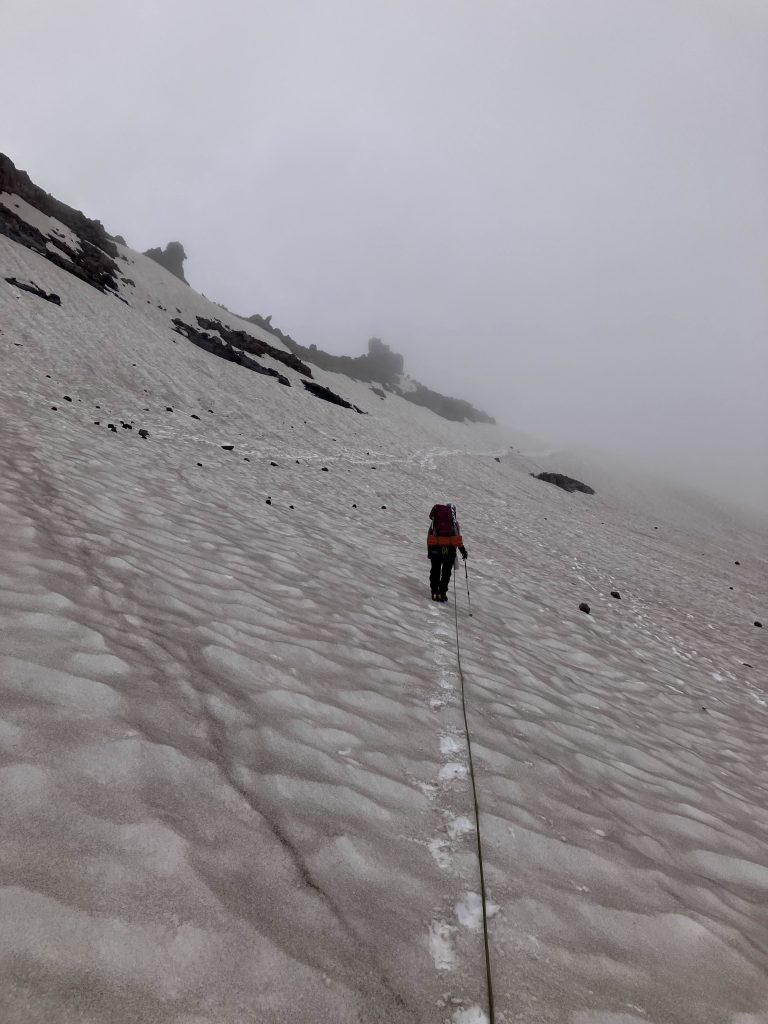
Day 2: Sunday, July 27
We packed up and left Upper Castle at 10:30 the next morning after a long rest and a leisurely start to the day. It was warm and toasty in the tent and sunny and windy outside with temps in the 50s during the day. Gusts might’ve been as high as 10-15mph on the ridge the night before, but for the most part we were sheltered from the wind and conditions were good climbing the Turtle Snowfield. This was an arduous walk up sun-cupped 30-40 degree snow. The snow surface was soft and slushy with a hard layer of consolidated slippery snow underneath. We climbed through midday, reaching Camp Hazard at 2PM. Camp Hazard is just below the rock step that marks the beginning of the Kautz route and is potentially compromised by large seracs and rockfall high above. It’s exposed and windy. Hesitant to overstay our welcome, we planned to nap here until 5pm and make a bid on the ice chutes in the early evening to do the technical crux in the remaining daylight. This would put us on the upper Kautz during the coldest part of the night, when snow bridges would be the most stable.
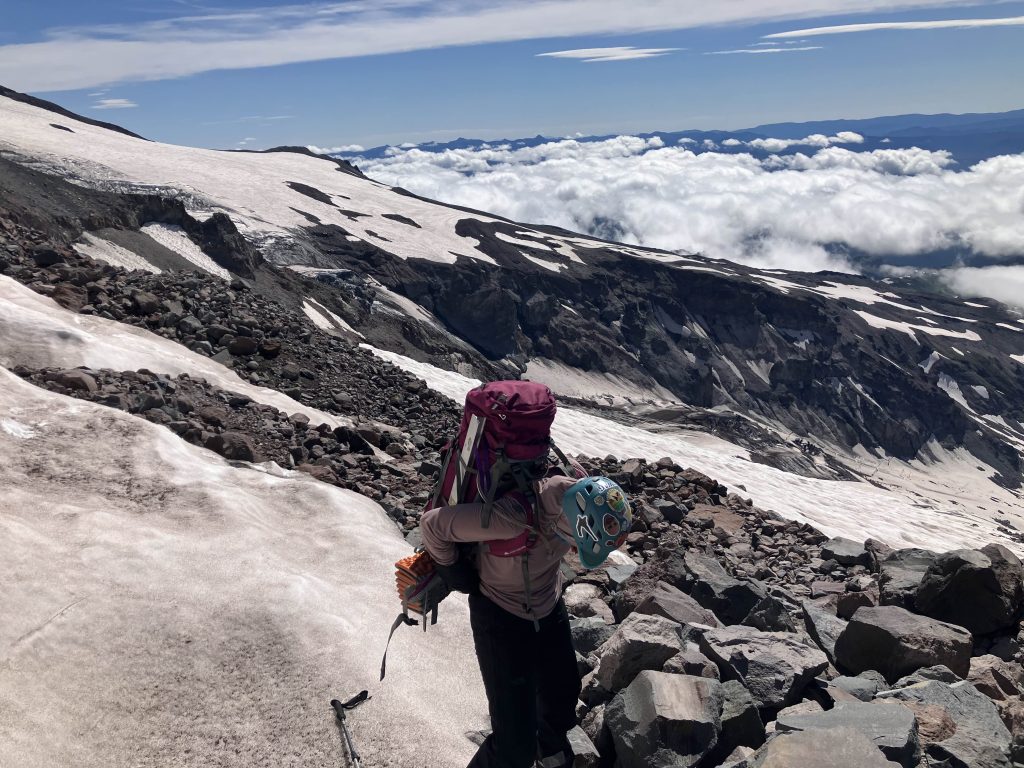
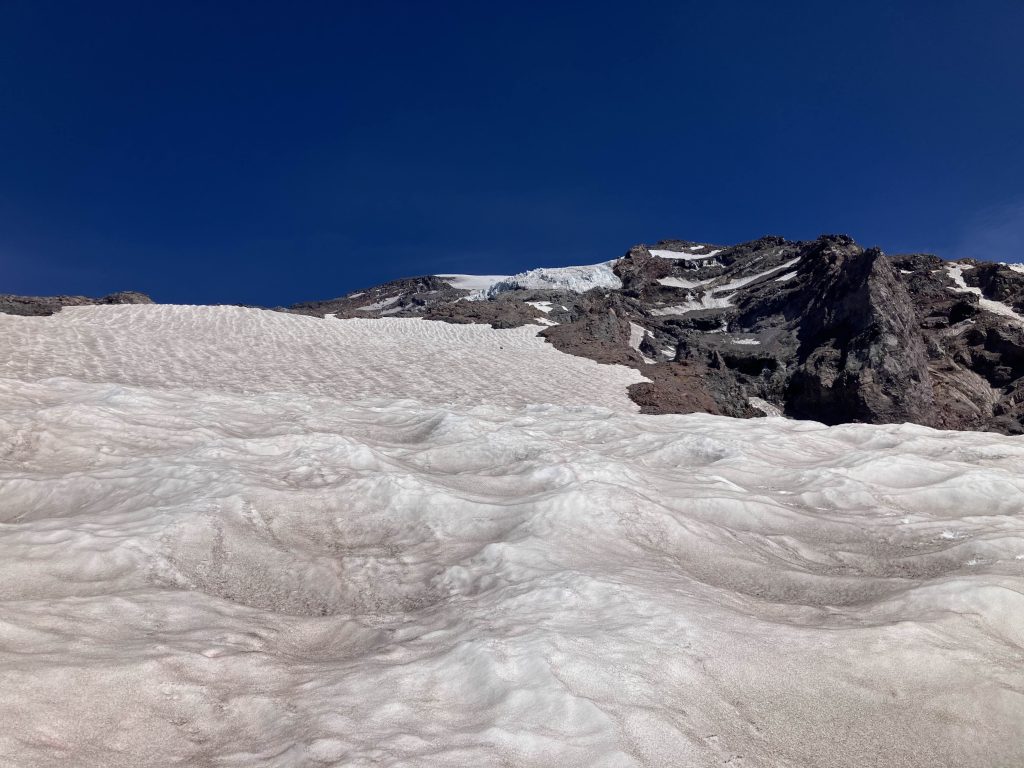
After resting and fueling up as best we could (the altitude was starting to get to me at nearly 11,300ft) we descended the rock step in an awkward half-belay half-downclimb process. My panic attack tendency reared its ugly head trying to scramble across the rockfall zone and onto the Kautz to the base of the route, nearly causing us to turn around, but I took some deep breaths and with some encouragement from Aiden we reached the base of the climb unscathed and calm. The Kautz is separated into two distinct ice slopes with a lower-angle snowfield in between. The ice was relatively bare and hard, with running water trickling down the center. The first ice slope varied in pitch from 45 to 60 degrees in chunky ledges for a general grade of AI2-. I led the first section in one 70m pitch followed by another 40m or so of steeper ice into the easy simul-terrain of the middle snowfield. The ice was in prime condition, an inch or two thick layer of crusty alpine ice over plastic, blue glacier. The sticks were good, and the screw placements (we took eight ice screws) were better. Climbing through the first slope was smooth and comfortable, albeit a little gripping to look down and see the massive ice cliffs below and the seracs above and to the climbers right. Not bad for my first ice leads ever! I placed a picket and microtraxion where the grade eased off into the snowfield and we simuled to the base of the crux.
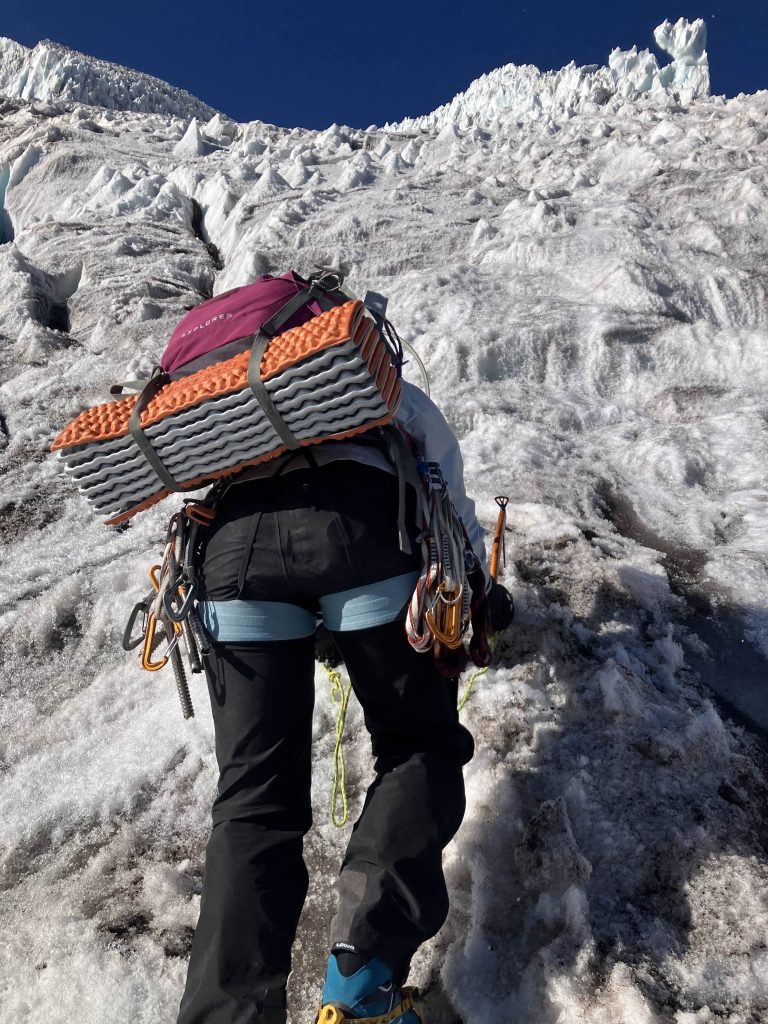
It was starting to get dark in the chute as the sun went over the ridge to the climbers left, so we decided to shorten our pitches such that we could easily stay in communication. I set off up the first pitch of the crux, which was slightly steeper than the first chute: a sustained 60-65 degree slope with smaller and fewer chunky ledges. I built an anchor 35m above the belay at a huge penitente. Despite the slightly headier moves, the ice was even better on the crux making for smooth, enjoyable climbing. I was getting tired though, so we decided to change leads here. Aiden was feeling good and more than happy to get some leads in on the crux.
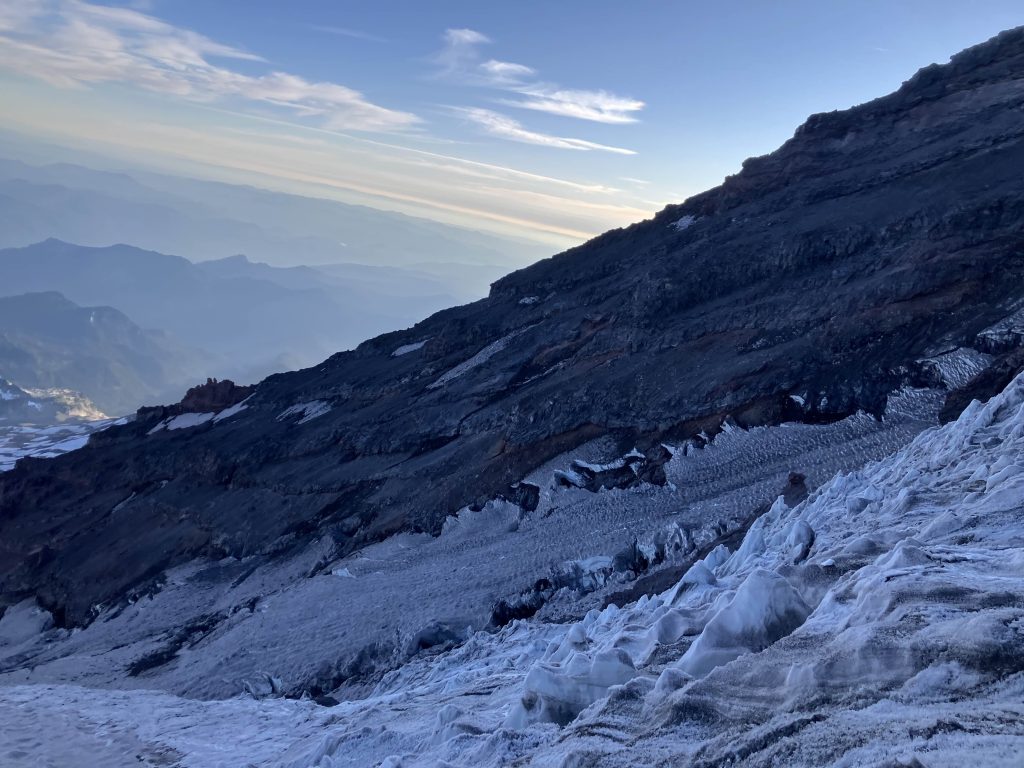
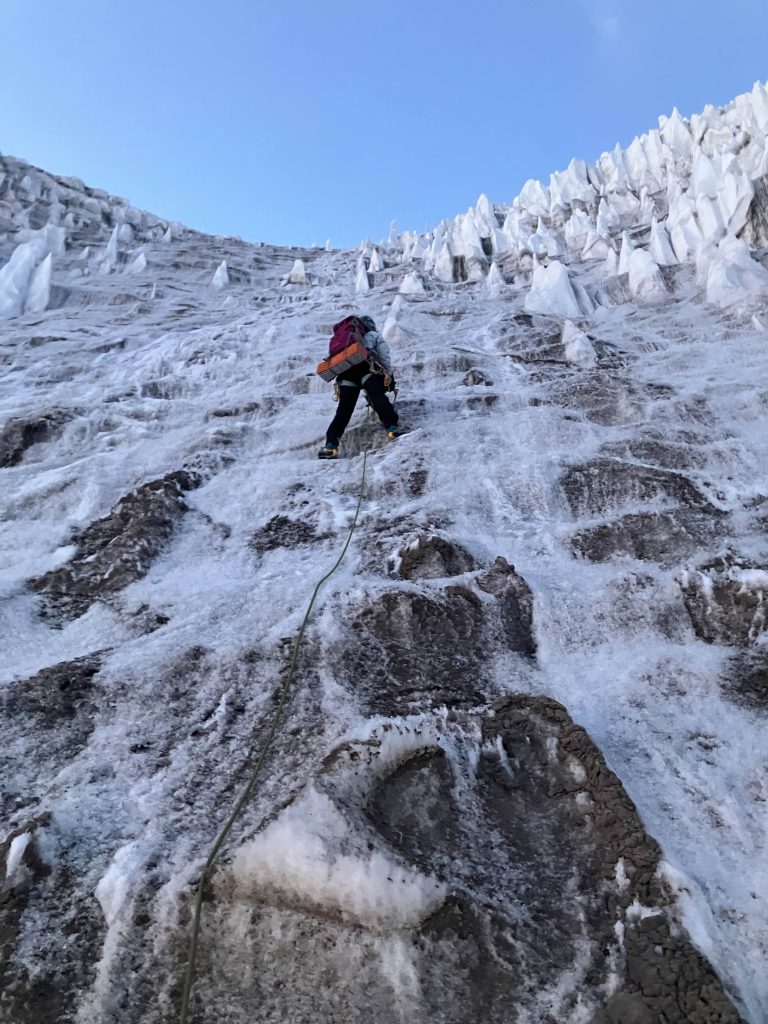
We climbed two more pitches of similar 65ish degree ice up and out of the crux, and then another pitch where the grade slowly eased off above the chute. The smooth, rolling ledges of alpine ice gradually sharpened into penitentes as the grade decreased. By this point it was completely dark and getting to be a brittle, biting cold in the low 20 degree range. After the fourth pitch we transitioned to roped glacier travel for the upper Kautz with Aiden leading. This turned out to be fighting through knee-to-waist high penitentes. We trended to the right, encountering larger and larger crevasses along the way. Had it been light, we would have been able to see a rather obvious path up the left side of the Kautz avoiding the largest of the crevasses, but instead we found ourselves crossing a couple dubious snow bridges. One of these was only a few feet wide and overhanging on one side, though eight or ten feet deep and stable, requiring an acrobatic shimmy across. Aiden scrambled across without any issues, but after the mental toll of the ice chute and the disconcerting blanket of darkness above (and now below) me I felt the effects of my panic attacks once again. I attempted to mount the snow bridge and promptly freaked the fuck out. Aiden set up a belay and I tried again, slowly but surely inching my way across. In hindsight, we could have handled this a lot better. For one, our route finding in the dark took us through an objectively suspicious part of the Kautz, when we should have opted for more walking across a safer part of the glacier. Secondly, I didn’t ask enough questions about this snowbridge crossing – I assumed Aiden wouldn’t be able to come back across, and that our only option was for me to buck up and figure out a way to do a snow bridge cross I was obviously uncomfortable with, when in reality he could have come back easily and we could have looked for a better place to cross. Instead I made a knee-jerk assumption and then put myself in an objectively worse mental state in an already risky situation, damaging our communication. This was the last of my “panic” moments for the route, but unfortunately not the last of our dubious snow bridge crossings.
We continued to weave through penitentes, now slowly but surely aiming towards the top of the Wapowety Cleaver. It was bitterly cold at this point. Our water was freezing and the going was slow. Penitentes made for difficult movement and obscured complex intersecting crevasses. At one point I even broke through an ice bridge up to my hip, warranting a yelp of surprise. Luckily the crack was small and I was able to wiggle my way out without issue. We crossed the Wapowety Cleaver at 13,000ft in an attempt to gain the upper Nisqually glacier and make a break for the summit, but Aiden shortly discovered a house-swallower crevasse with no end in sight. We were dead-ended, freezing cold and uncomfortable with the prospect of wandering around the upper Nisqually in the dark. We set up an emergency bivvy in a sheltered spot on the Nisqually side of the cleaver at 3:20AM with the intention of hunkering down until we had enough daylight to continue.
Day 3: Monday, July 28th
Three hours of the coldest sleep of my life later, we were up and moving again at 6:30AM. We walked a short ways down the Wapowety Cleaver, discovering some intended bivvy sites (if only we knew!) and then once again out onto the Nisqually. A criss crossing of house-swallowers appeared to be the last big obstacle before the last penitente covered slog to the summit. Inspecting the crevasses, I found a point with a big but awkwardly pyramid-shaped snowbridge. I remember saying to Aiden “it’s gonna be scuffed, but it’ll go.” I scrambled across without issue, but I was uncomfortably aware that the peculiar shape of the bridge made it difficult to tell which parts were well supported by the ice underneath it.
Once again in hindsight, it’s easy to see that we have become a little too comfortable with snow bridges. I’ve never taken a big fall into a crevasse, nor have I seen any larger structures collapse in person, besides hearing a serac fall from the other side of the mountain on Kulshan. Examining snow bridges carefully and setting up belays certainly helps mitigate some risk, but even with a belay the consequences of a partial or full bridge collapse or fall in this situation would have certainly meant injury and could possibly be fatal. There were enough unknowns here (how stable is this bridge actually and which parts are the most stable, when would it collapse, how would it collapse) that I don’t want to include this kind of exposure regularly into my risk tolerance. I’m glad that nothing notable happened. It won’t be a habit from here on out.
Luckily for us, this was indeed the greatest of our remaining worries. It was shaping up to be a beautiful, cloudless day. The remaining walking up to the summit was an uneventful slog through the never-ending penitentes, with some end running of a few large crevasses and another couple of snow bridges which were thankfully uncomplicated. We reached the summit at 11:30AM. I don’t think I’ve ever been that tired in my life, and we still had all the way down to go.
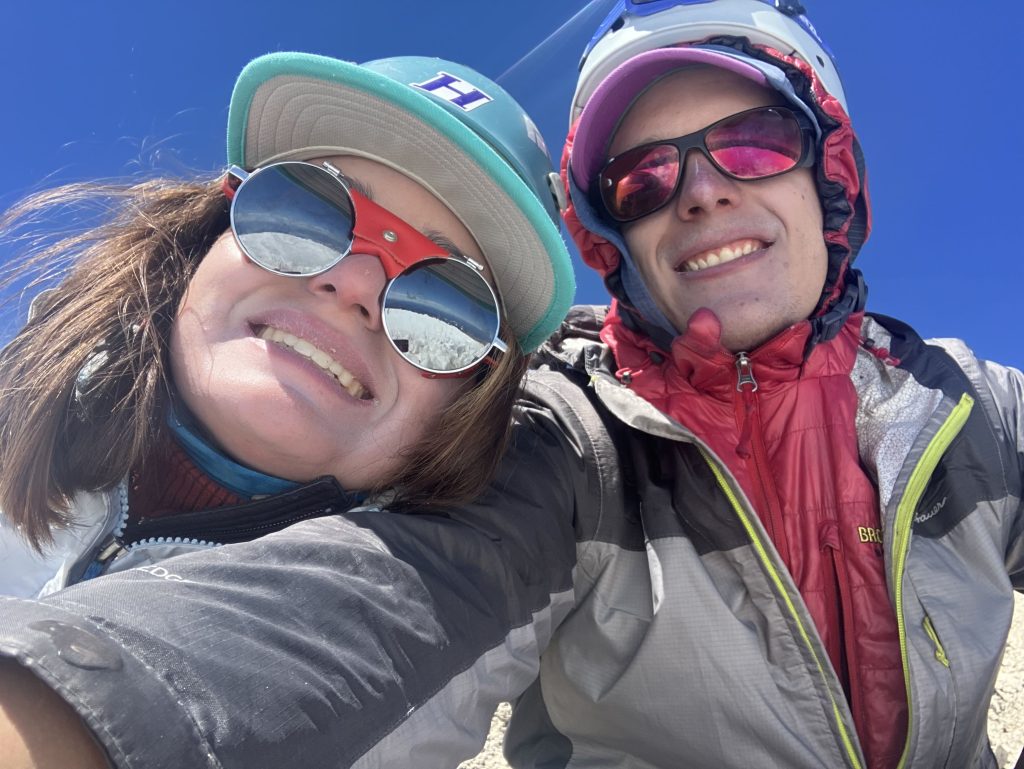
We took the DC route down. It’s beautiful, and really has anything a beginner mountaineer (or anyone looking for something less involved that what we just did) could want. Beautiful views, a handful of ladders across yawning crevasses, and a bit of easy scrambling on the cleaver. I enjoyed myself coming down in spite of my body feeling like it was going to collapse. We moved quickly through the icebox, high crack and bowling alley, and finally relaxed once we reached Camp Muir. By the way, I think Camp Muir is possibly the best place to be if you want to talk to someone who understands what the hell you’ve just been through after fighting for your life on the Kautz. Arriving beaten down mentally and physically, we were greeted by friendly climbers who refilled our water and asked us about the trials and tribulations of our quest. We discussed the conditions on the DC route and how good it was going to feel to be home. Also I forgot my water bottle at Camp Muir, so on the off chance anyone reads this and finds it, it’s a green and pink Owala. Please send me an email or something! I love that thing and miss it already.
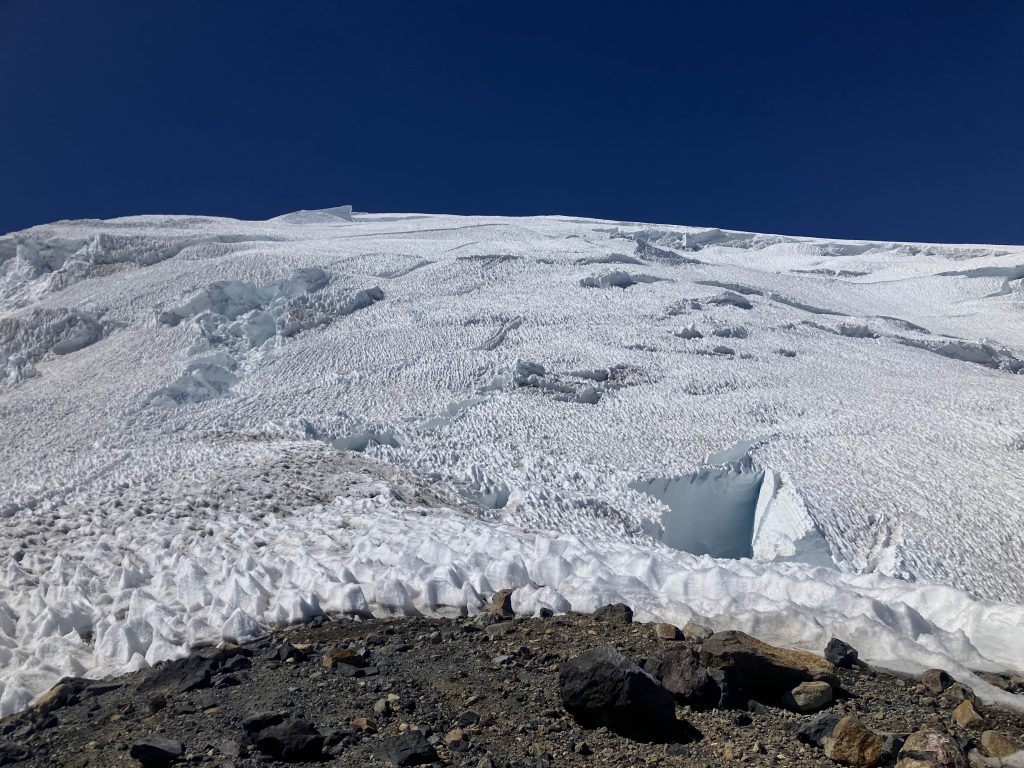
The Muir snowfield was a surprisingly fun descent, with sections of slippery plunge stepping and glissading. It felt like we were only walking for a short time before we were back on the Skyline trail down from Panorama Point. I told Aiden later that this section felt like the longest and hardest part of the descent, despite objectively being the easiest and shortest. My feet hurt so badly walking on the trail after wearing mountaineering boots for 26hrs that I was in tears. I was counting my steps by the 100s to get down to the parking lot. We made it back to Seattle around midnight, just in time for a stop at Dick’s Drive in before collapsing at home. What a day.
Debrief
Technical Gear Brought:
- 70m rope
- 8 ice screws
- v-thread tool
- single and double length slings for anchors
- glacier travel kit (lockers, tibloc, prussik cord)
- 2 microtraxions
- 2 pickets
- 2 ice tools per person
Mistakes:
- Getting too comfortable with sketchy snow bridge crossings
- Shaky communication when crossing snow bridges
- Underestimating the time and commitment of the approach
Victories:
- Great selection of rope techniques and transitioning between them!
- We summited!
- Decision making during the crux and on the glaciers was solid: choosing to bivvy when we did, when to move fast to avoid overhead hazard, when to set up belays.
Other Comments:
- Hot take, I’m glad we started the crux pitches in the evening despite the issues we had with the cold on the upper Kautz. The ice was the perfect temperature and it felt good to have some light for the ascent. I think this plan worked out well for us being beginner ice climbers and therefore on the slower end – in the future I would want to have the fitness and experience to climb the Kautz in two long days starting the ice pitches in the early morning.
- Climbing never really got harder than AI2+, but in the late season this is all solid ice without a lot of snow and it absolutely eats screws. The rangers told us that recent parties were calling it AI3 and personally I think this is a bit of an overstatement. Since the climbing is so sustained and has little snow on it it’s a bit heady and needs to be taken seriously, but the movement is straightforward and pretty low-angle with lots of big hands-free ledges for placing pro and building anchors. I’d call it AI2 with a side of good old fashioned fun.
- For conditions similar to ours, I would want at 6 screws minimum, perhaps up to 10. The party of two that passed us on Day 1 turned around because they only had a 30m rope and had planned to simul a great deal of the route. We were comfortable pitching things out in full rope lengths with our 70m rope and 8 ice screws. The party of two behind us had a 50m rope and 6 screws and passed us right around the time we started moving post-bivvy.
- The approach to this climb in the late season is complicated and annoying with moraine crossings and lots of bare glacier. I imagine it’s a lot more straightforward in the early season, and the climbing is most likely easier as well on the crux pitches with some more snow and ice. If the prospect of sustained AI2 on solid ice is a little too freaky, I might opt for an ascent in May or June instead.
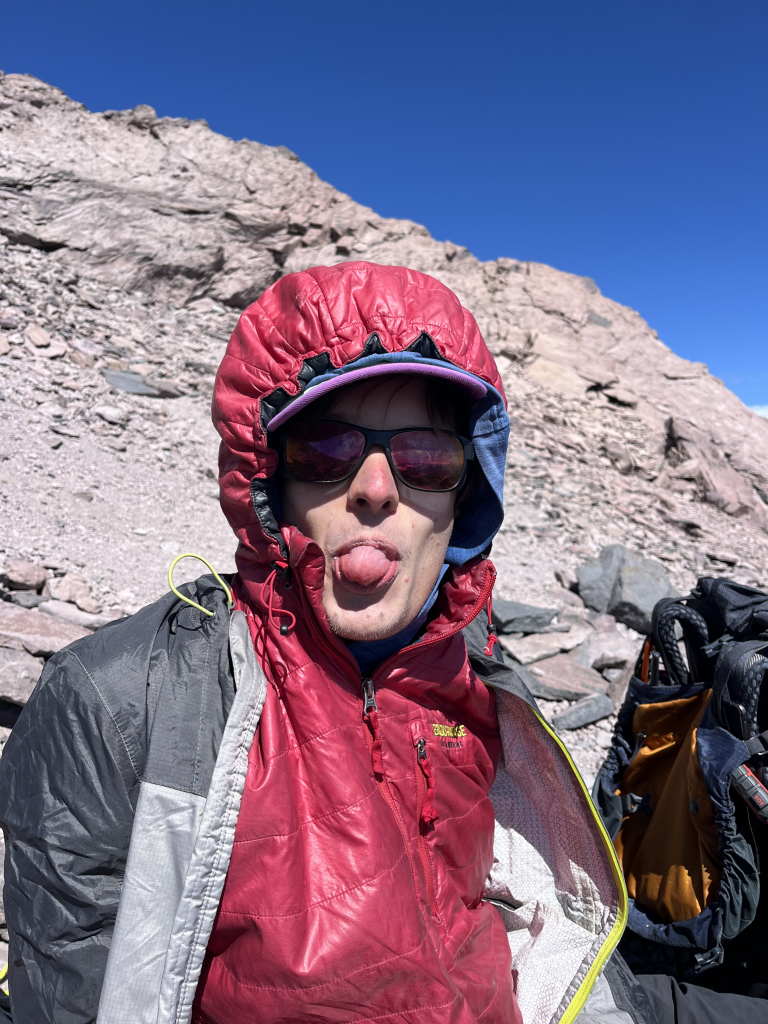
Man, between this trip and North Ridge I think I might have a newfound love in ice climbing. That being said I wouldn’t mind a long break from 20+ hour pushes. Kautz is a great route. In the late season it’s tough, committing and starkly beautiful with some great alpine ice. You’re going to love it.
-M
Leave a Reply